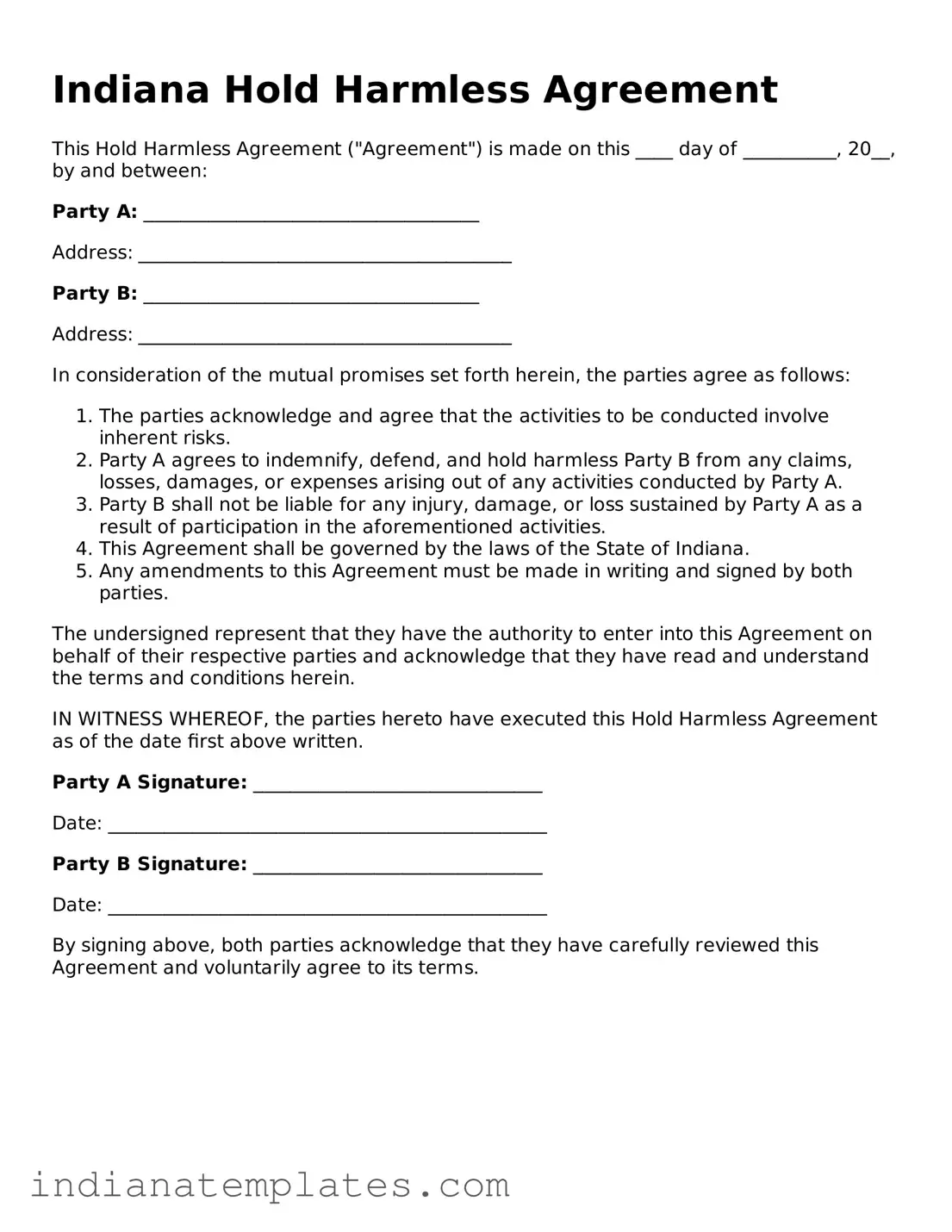The Indiana Hold Harmless Agreement is similar to a Liability Waiver. Both documents are designed to protect one party from legal responsibility for injuries or damages that occur during an event or activity. A Liability Waiver typically requires participants to acknowledge the risks involved and agree not to hold the organizer responsible. This document is often used in recreational activities, sports events, and other situations where participants might face potential harm. By signing, individuals accept the inherent risks and relinquish their right to seek compensation from the organizers.
Another document that shares similarities is the Indemnity Agreement. Like the Hold Harmless Agreement, an Indemnity Agreement involves one party agreeing to compensate another for any losses or damages that arise from specific actions or events. This document is commonly used in business transactions and contracts, where one party may assume the risks associated with a particular operation or service. It provides a layer of protection, ensuring that the indemnifying party will cover any financial burdens that may result from their actions.
For those looking to develop a structured workplace environment, utilizing the essential guidelines for an Employee Handbook can be incredibly beneficial. This document serves as a foundational tool for clarifying company policies and expectations.
A Release of Liability form is also akin to the Hold Harmless Agreement. This document allows individuals to release another party from legal claims related to injuries or damages that may occur during an activity. Often used in sports, fitness, and outdoor events, a Release of Liability emphasizes the participant's understanding of the risks involved. By signing this document, individuals agree not to pursue legal action against the organizers, thereby safeguarding them from potential lawsuits.
Similar to these documents is the Consent to Treat form, which is often used in medical settings. While it primarily focuses on granting permission for medical treatment, it also includes language that protects healthcare providers from liability in case of unforeseen complications. Patients acknowledge the risks of treatment and agree not to hold the medical professionals responsible for outcomes that may arise. This ensures that providers can offer necessary care without the fear of litigation.
The Non-Disclosure Agreement (NDA) is another document that can be compared to the Hold Harmless Agreement, though it serves a different purpose. An NDA protects sensitive information shared between parties, ensuring that the recipient does not disclose confidential details to others. While it does not directly address liability, it safeguards the interests of the party sharing proprietary information. In business relationships, this agreement helps build trust and protects against potential misuse of shared knowledge.
A Service Agreement also bears resemblance to the Hold Harmless Agreement. This document outlines the terms and conditions under which services will be provided, often including clauses that limit liability for the service provider. By clearly defining the responsibilities and expectations of both parties, a Service Agreement helps prevent disputes and establishes a framework for accountability. It reassures clients that they are protected while receiving services, similar to the assurance provided by a Hold Harmless Agreement.
The Partnership Agreement is another document that shares some characteristics with the Hold Harmless Agreement. This agreement outlines the terms of a partnership, including the distribution of profits, responsibilities, and liability among partners. It often includes provisions that limit personal liability for business debts, protecting partners from financial risks associated with the business. Like the Hold Harmless Agreement, it establishes a clear understanding of each party's role and risk exposure.
A Construction Contract is also similar, particularly regarding liability. In construction projects, these contracts often include clauses that address indemnification and hold harmless provisions. They protect the contractor from claims arising from accidents or damages that occur on-site. By outlining responsibilities and expectations, these contracts help ensure that all parties understand their liability and the associated risks of the construction process.
The Rental Agreement is another document that can be compared to the Hold Harmless Agreement. This agreement outlines the terms of renting property, often including clauses that limit the landlord's liability for injuries occurring on the premises. Tenants typically agree to hold the landlord harmless for accidents that may happen, thus providing a layer of protection for property owners. This mutual understanding helps maintain a positive landlord-tenant relationship while addressing potential risks.
Finally, the Employment Agreement can also reflect similar themes. This document outlines the terms of employment, including responsibilities, compensation, and liability. Many Employment Agreements include clauses that protect employers from claims related to workplace injuries or disputes. By establishing clear expectations and responsibilities, these agreements help foster a safe working environment while minimizing the risk of legal issues arising from employment-related matters.
